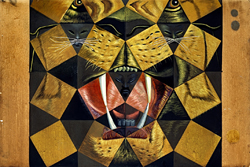
Salvador DALÍ
Spanish 1904–89, worked in United States 1940–48
Portrait of Gala 1969
pencil on cardboard
55.8 x 42.9 cm
Fundació Gala-Salvador Dalí, Figueres
© Salvador Dalí, Fundació
Gala-Salvador Dalí, VISCOPY, 2009

Salvador DALÍ
Spanish 1904–89, worked in United States 1940–48
Study for Fifty abstract paintings which as seen from two
yards, change into three Lenins masquerading as
Chinese and as seen from six yards, appear as the
head of a Royal Bengal Tiger (c. 1962)
oil and gouache on cardboard
51.0 x 76.0 cm
Fundació Gala-Salvador Dalí, Figueres
© Salvador Dalí, Fundació
Gala-Salvador Dalí, VISCOPY, 2009
Dalí’s eclipse in America in the 1950s can be ascribed to two things. His return to Franco’s Spain,away from the glare of the US media, and the rise of Abstract Expressionism, championed by critics who had no time for Surrealism. By now, however, Dalí had financial independence and could afford to focus on the scientific and religious subjects that were increasingly absorbing him. In due course too Abstract Expressionism would come to be supplanted by Pop Art in the 1960s, and its artists, such as Andy Warhol, Roy Lichtenstein and Claes Oldenburg. Many of their methods, including their impersonal precision, realism, and ironic detachment owe much to Dalí.
Dalí felt vindicated and gratified to come into contact with this new generation of artists, closer to his views. He enjoyed something of a Renaissance in popularity, and acquired an entourage of young admirers in Spain and New York. In his ceaseless quest for ever-greater realism, Dalí embarked on a series of optical illusions in the 1960s through to the 1980s. They included stereoscopic double paintings, designed to be viewed with a lens, and holograms which used the 1971 Nobel prize research of Dennis Gabor to create spectacular three-dimensional imagery. Dalí’s interest during the late phase of his career in spirituality, extra dimensions in art, and new modes of perception, brought him into synch with many of concerns of his time. He believed, however, that the true significance of his projects continued to elude the contemporary generation. ‘My present ideas will be clear some forty years from now’ he declared, to which he added that he did not ‘wish them to be accessible any earlier than that’.
